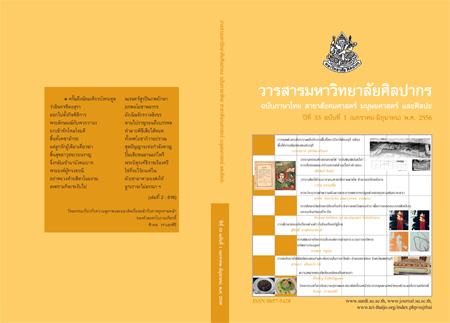วัจนกรรมเกี่ยวกับความสุภาพและแนวคิดเรื่องหน้า กับการคุกคามหน้าของตัวละครในรามเกียรติ์ The Speech of Politeness and Face Concept with Face - Threatening Act of Characters in Ramkien’s King Rama I
Main Article Content
Abstract
บทความนี้มีจุดมุ่งหมายเพื่อศึกษาวัจนกรรมเกี่ยวกับความสุภาพและแนวคิดเรื่องหน้ากับการคุกคาม หน้าของตัวละครในรามเกียรติ์ ฉบับพระราชนิพนธ์ในพระบาทสมเด็จพระพุทธยอดฟ้าจุฬาโลกมหาราช โดยศึกษาผ่านตัวละครที่แบ่งออกเป็น 2 ฝ่าย คือ 1) ฝ่ายพลับพลา และ 2) ฝ่ายลงกา โดยมุ่งศึกษาตามหลักความสุภาพทั้งหมด 6 ข้อและตัวแปรเสริมทางด้านวัจนปฏิบัติด้านความสุภาพซึ่งจะใช้กรอบแนวคิดหลักความสุภาพของลีช อีกทั้งจะศึกษาเรื่องหน้าและการคุกคามหน้าทั้งเชิงบวกและเชิงลบตามแนวคิดของบราวน์และเลวินสัน
ผลการศึกษาพบว่า ตัวแปรเสริมทางด้านวัจนปฏิบัติทั้ง 4 ประการ อันได้แก่ 1) อำนาจ 2) ระยะห่างทางสังคม 3) ขนาดของความรบกวน และ 4) สิทธิและพันธกรณี จะเข้ามามีบทบาทต่อการกำหนดความสุภาพของการใช้ถ้อยคำของตัวละครในรามเกียรติ์แต่จะไม่ปรากฏตัวแปรด้านสิทธิและพันธกรณีอย่างเด่นชัดเท่าใดนัก อีกทั้งหลักความสุภาพของลีชมีทั้งหมด 6 ข้อ ได้แก่ 1) หลักรู้ผ่อนหนักผ่อนเบา 2) หลักความเอื้อเฟื้อ 3) หลักชื่นชมยินดี 4) หลักถ่อมตน 5) หลักคล้อยตาม และ 6) หลักเห็นใจ ซึ่งจะปรากฏเพียง 5 ข้อเท่านั้น ซึ่งจะไม่ปรากฏหลักหลักคล้อยตาม อันแสดงให้เห็นว่าสังคมรามเกียรติ์ที่ถือว่าเป็นสังคมในโลกวรรณคดีนั้นจะเป็นสังคมที่ตัวละครที่ดำเนินการสื่อสารซึ่งใกล้เคียงกับสังคมมนุษย์จริง จึงทำให้เห็นถึงการสื่อสารของตัวละครได้เป็นอย่างดี อีกทั้งการสื่อสารในแต่ละครั้ง ตัวละครในรามเกียรติ์จะสื่อสารโดยใช้ถ้อยคำหรือภาษาที่สุภาพแต่เมื่อตัวละครสื่อสารกับตัวละครฝ่ายตรงข้าม ตัวละครจะใช้ถ้อยคำที่แสดงการคุกคามหน้าของตัวละครอื่นซึ่งจะปรากฏทั้งการคุกคามหน้าเชิงลบและการคุกคามหน้าเชิงบวกโดยส่วนใหญ่จะนิยมใช้วัจนกรรมตรง นับเป็นปัจจัยสำคัญที่ทำให้ตัวละครในรามเกียรติ์ที่ถูกคุกคามหน้านั้นเสียหน้า จนนำไปสู่การสูญเสียศักดิ์ศรีอีกด้วย
คำสำคัญ: 1. วัจนกรรมเกี่ยวกับความสุภาพ. 2. แนวคิดเรื่องหน้า. 3. การคุกคามหน้า. 4. ตัวละครในรามเกียรติ์.
Abstract
This article is aims to study the speech of politeness and face concept with face-threatening act of characters in Ramkien’s King Rama I, and to study by dividing 2 groups is 1) Plup-Pla group and 2) Long-Ka group. Besides to study in Politeness Principle 6 maxims and pragmatic parameters of politeness by Politeness Principle of Leech. Furthermore, to study about face concept and face- threatening act both positive and negative by Politeness Theory of Brown and Levinson.
The result of study shows the four parameters related to pragmatics: power, social distance, size of imposition, and rights and obligations have the effect on the politeness of speech which is used by characters in Ramkien’s King Rama I. However, the use of the parameter of rights and obligations is quite obscurely. Moreover, the principle of politeness by Leech has six maxims: tact maxim, generosity maxim, approbation maxim, modesty maxim, agreement maxim, and sympathy maxim. Nevertheless, only 5 maxims are found in this study, excluding agreement maxim. It shows that a society in Ramkien’s King Rama I, which is considered as the society in literature’s World, is the society that the characters play the role in communication similar to the real human’s society. Therefore the communication of the characters is easy to understand. Moreover, the characters in Ramkien’s King Rama I usually use the polite speech to communicate, but, if the characters must to communicate with opposite characters that they always communicate by face-threatening acts both positive and negative. Almost they are using the direct speech act which will make the interlocutors in Ramkien’s King Rama I lose their faces and can make the characters which are threaten to reduce prestige.
Keywords: 1. Speech of Politeness. 2. Face Concept. 3. Face-Threatening Act. 4.Characters in Ramkien’s King Rama I.


